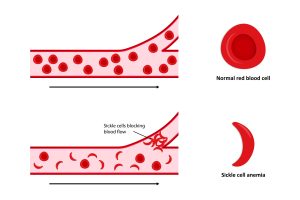September is National Sickle Cell Awareness Month, designated by Congress to highlight the need for research and treatment of sickle cell disease (SCD). The Centers for Disease Control and Prevention (CDC) defines SCD as a group of inherited red blood cell disorders that affect the hemoglobin, the iron-rich protein that carries oxygen. Normal red blood cells are disc-shaped and flexible, allowing them to move through blood vessels easily. However, due to the genetic mutation, the red blood cells have transformed into a crescent or “sickle” shape that are hard and sticky. These sickle-shaped red blood cells can clog small blood vessels, disrupt blood flow and cause pain and serious health issues such as deep vein thrombosis, stroke, and organ damage.

A genetic mutation creates sickle-shaped red blood cells, which are not as efficient at carrying iron and can lead to what is called Sickle Cell Anemia. (Photo source: Adobe Stock)
Sickle cell disease is inherited when a person receives one or two genes for the abnormal hemoglobin S, one from each parent. People with only one abnormal hemoglobin S gene and a normal hemoglobin gene have sickle cell trait (HbAS) and typically do not show signs of the disease. Other abnormal hemoglobin genes, such as “C,” “D,” “E,” or “O,” can also be inherited alongside the hemoglobin S, often resulting in milder forms of SCD. The most severe form, sickle cell anemia (HbSS), occurs when a person inherits two abnormal hemoglobin S genes. In the United States, one to three million people have the sickle cell trait, and more than 100,000 people have SCD, many of whom are of African descent or identify as Black. Globally, about two million people have SCD, and over 100 million carry the trait. SCD also affects individuals of South Asian (specifically Indian), Hispanic, Middle Eastern, and Southern European ancestry.
Sickle cell disease can be detected at birth through routine screening, with symptoms typically appearing around six months of age. These can range from mild to severe and include anemia, pain crises, swelling in extremities, infections, delayed growth/puberty, and vision problems. Although SCD is a life-long disease, there are treatments available to manage symptoms and improve quality of life. A bone marrow transplant was previously the only cure, but two new gene therapies approved by the FDA in December 2023 offer additional treatment options. Other treatments such as medication and blood transfusions can also help reduce symptoms and prolong life.
Individuals, particularly those with a family history of sickle cell disease or from high-risk populations, may consider seeking a genetic counselor; understanding their carrier status can help them make informed family planning decisions. When both parents have the trait, each pregnancy has a 25% chance of resulting in a child with sickle cell anemia. If only one parent has the trait, there is a 50% chance that the child will inherit the sickle cell trait. Historically, individuals with sickle cell anemia rarely lived past the age of five. Today, advances in modern medicine have extended life expectancy into the fifties, though this remains significantly lower than the average life expectancy. That is why this month is important. Increasing awareness about SCD is essential for increasing research and its funding, improving treatment options, and supporting those affected.
Sources:
Centers for Disease Control and Prevention – https://www.cdc.gov/sickle-cell/about/index.html
Sickle Cell Disease Association of America – https://www.sicklecelldisease.org/get-involved/events/national-sickle-cell-awareness-month/
National Heart, Lung, and Blood Institute – https://www.nhlbi.nih.gov/health/sickle-cell-disease
Mayo Clinic – https://www.mayoclinic.org/diseases-conditions/sickle-cell-anemia/symptoms-causes/syc-20355876
Cleveland Clinic – https://my.clevelandclinic.org/health/diseases/4579-sickle-cell-anemia
American Society of Hematology – https://www.hematology.org/education/patients/anemia/sickle-cell-trait
An Equal Opportunity Institution.
- The Deal with Debt: Personal Finance Series (Part 5) - November 21, 2025
- A Practical Guide to Credit: Personal Finance Series (Part 4) - November 21, 2025
- Today’s Risk for Tomorrow: Personal Finance Series (Part 3) - October 24, 2025
